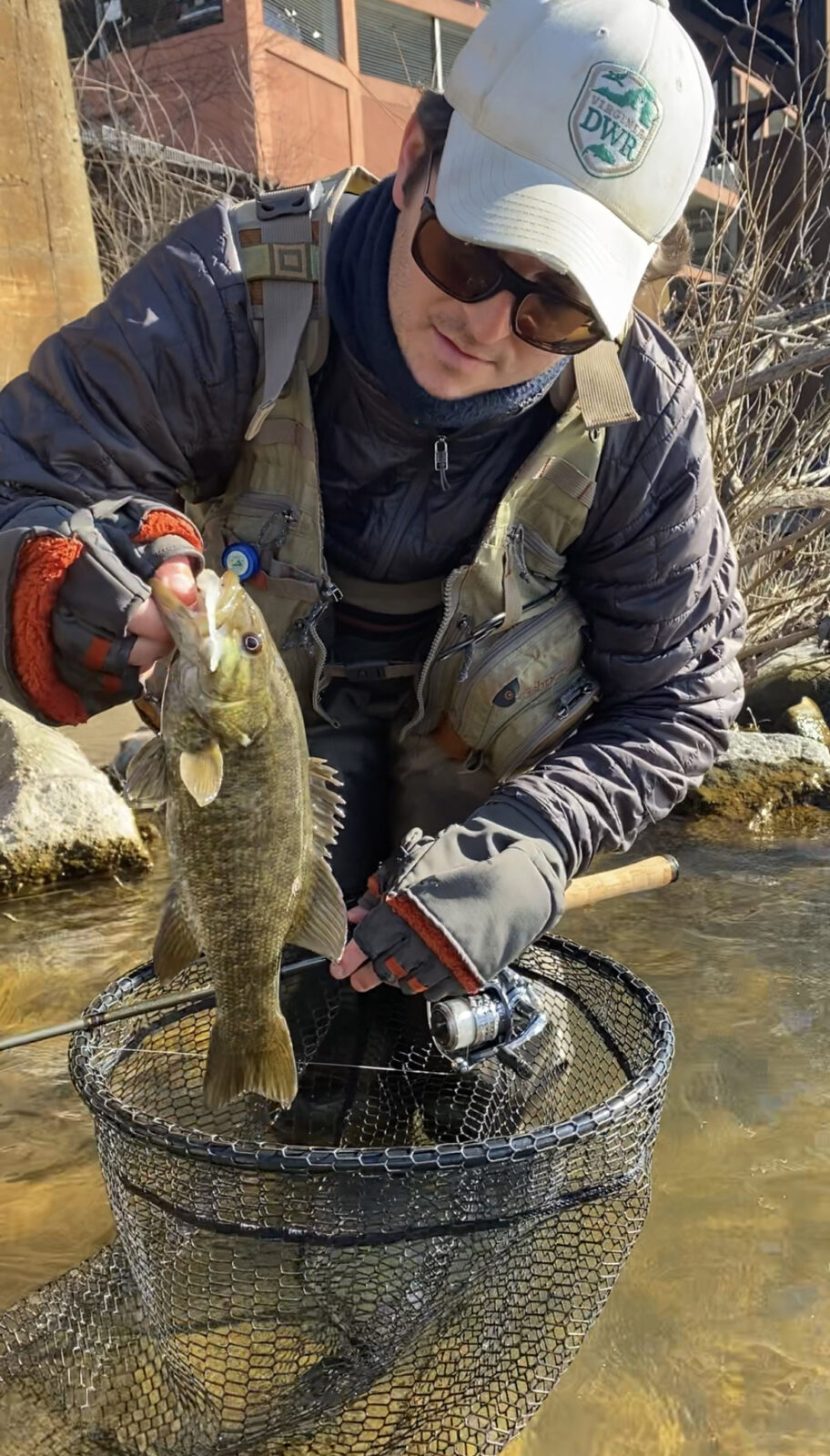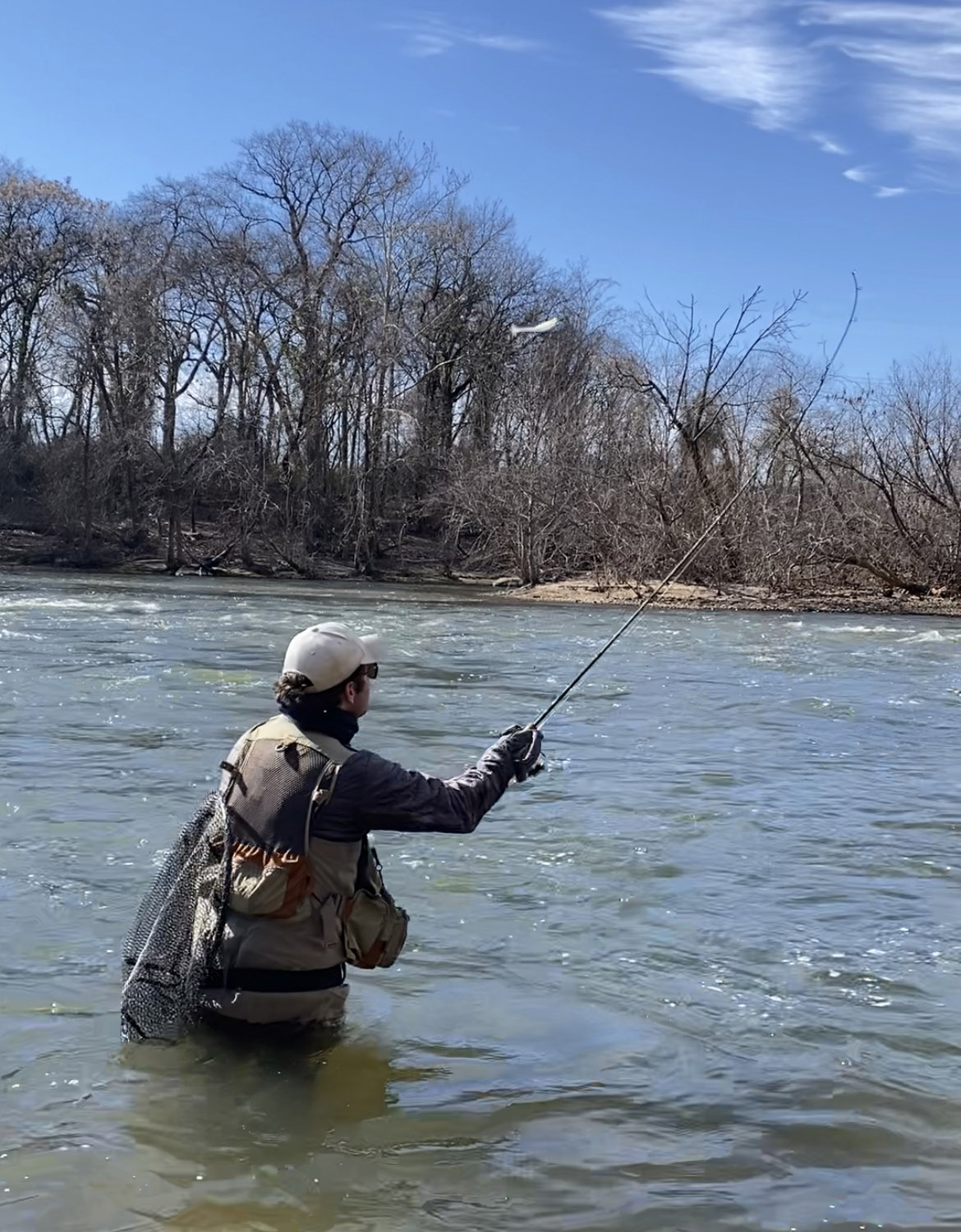
Fishing for Smallmouth Bass During the Coldest Months of the Year
By Alex McCrickard/DWR
Photos by Alex McCrickard/DWR
During the coldest months of the year, anglers will often find solitude on the river. Many will choose to wait the winter out, cozying up to a fire inside the warmth of their homes. However, for the angler that does choose to brave the elements out on the water, patience and persistence are essential to success. Fishing for smallmouth bass in the wintertime can be downright challenging. But if you know where to look and focus your time and energy on warming trends, you can find success even in the dead of winter.

Keep an eye on conditions and temperatures for the best chance of smallmouth success in the winter. And make sure to dress warmly!
Winter Conditions
Fishing for smallmouth bass during the winter is all about focusing time and energy on the right habitat. If you float the river, hitting all the water that holds fish in the summer months, you will likely turn up empty-handed. As water temperatures plummet through the month of December and into early January, smallmouth bass retreat to their winter holes. The size of their winter holes can vary depending on the size of the river. On larger rivers like the New or the James, winter holes can be significantly larger when compared to smaller tributaries. On bigger rivers, prime winter holes may have depths of up to 15 feet or more and might be 30 to 50 yards or more long. On smaller rivers, winter holes might only be five to six feet deep.
Smallmouth retreat to these holes in the winter months due to the cover they provide. In these holes, smallmouth can avoid having to move in both high-water and low-water scenarios. Remember, as water temperatures drop in the winter, the enzymes that these fish use to digest their food are very slow-acting. This slow metabolism makes smallmouth fairly lethargic from late December through January and February and deeper holes provide the best opportunity for smallmouth to stay put and not exert unnecessary energy. These holes can typically be found below shelfs, in river bends, or in the middle to the tail-out of a long pool.
Water Temperatures and Fishing Windows
Fishing low and slow is key to getting a bite during this time of the year as smallmouth are tight to the bottom. Getting your presentation close to the bottom and working the lure or fly slowly is essential as the fish are not going to be racing after your presentation like they would in the summer months. With a slower metabolism, they just don’t have to eat as much to maintain their body weight. Getting your presentation as close to their face as possible is key.
Fishing can be especially challenging in cold water when temperatures are in the mid-30s. There is no reason to rush to be on the river at sunrise during this time of the year. From my experience, the best time of the day is the warmest window from noon to about 4 p.m. I try to look for a trend of warming weather when planning a winter smallmouth trip. If the weather has been very cold with highs only in the low to mid 30s and nighttime temps in the teens, I prefer to wait for a string of weather where the daytime highs get into at least the mid-40s and the nighttime temps don’t drop much below 30 degrees.

Smallmouth behave differently in colder water, so make sure to shift techniques for the most success.
In an ideal scenario, there will be three to four days of warmer weather, and I’ll plan to fish during the prime afternoon window on the third or fourth day of a warming trend. Even if the water temperatures bump up only a few degrees, it can trigger a feeding window. I’ll look for sunny afternoons to bump water temperatures up from the mid-30s to upper 30s or—even better—upper 30s to low 40s. In these situations, opportunistic smallmouth will sometimes even move to the edges of their winter holes to forage when an opportunity presents itself.
Lures and Flies
As mentioned, fishing low and slow is key during this time of the year. Anglers fishing with the fly rod can still have success with full sinking line, bouncing streamers close to the bottom. But a much more consistent presentation is achieved when fishing with a spinning or conventional setup. A three- to four-inch swimbait fished on an 1/8 oz jig head is a good presentation slow rolled along the bottom. Tubes fished ned rig style can be worked painstakingly slow, ticking them along the bottom. Crankbaits and jerkbaits can also take fish when kept lower in the water column. Many winter smallmouth bass anglers swear by a jig and pig this time of the year. Whatever approach you choose, fish it slowly and let the fish dictate what’s working. Don’t be afraid to try various approaches in one winter hole before you figure it out.
Whenever fishing in the winter months, make sure to take all the proper safety precautions. Cold water and cold weather can put you at risk for hypothermia if you fall in and get wet. I always carry a dry bag with a towel and full change of clothes during this time of the year so I’m prepared just in case. Dress in layers and dress for the weather! When boating, always wear a life jacket and always let someone know where you are going and when you plan on returning. Refresh yourself with this article on cold weather paddling and fishing safety.
Consider scratching the itch with a winter smallmouth trip this year and best of luck on the water!
Alex McCrickard is DWR’s angling education coordinator.
Distribution channels:
Legal Disclaimer:
EIN Presswire provides this news content "as is" without warranty of any kind. We do not accept any responsibility or liability for the accuracy, content, images, videos, licenses, completeness, legality, or reliability of the information contained in this article. If you have any complaints or copyright issues related to this article, kindly contact the author above.
Submit your press release